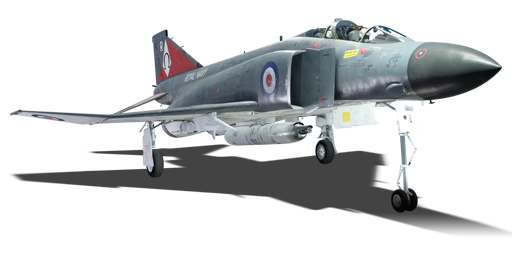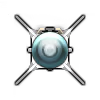



By the late 1950s, the Fleet Air Arm were looking to replace their roster of ageing de Havilland Sea Vixens. Having dropped the idea of a navalised version of the P.1154 (a supersonic development of the P.1127, which was itself the predecessor of the Hawker Siddeley Harrier), they instead decided to purchase a customised variant of the F-4 Phantom II from the United States. The Phantom FG.1, also known as the F-4K, was created from the F-4J with a number of modifications, including a hingeable nose radome and longer front gear leg to adapt it to the smaller British carriers, as well as the installation of the larger and more powerful Rolls-Royce Spey turbofan engines. From April 1968, 48 aircraft would be delivered to the Fleet Air Arm; however, issues would soon be encountered, namely in that the heat produced by the afterburning Spey engines would cause the flight deck plating to buckle and melt. Ultimately, only HMS Ark Royal (R09) would be refitted to operate the Phantom FG.1, carrying 28 aircraft, and they would remain in service until the Ark Royal's decommissioning in 1978, after which the aircraft were transferred to RAF service.
Introduced in Update "Starfighters", the Phantom FG.1 is very similar to the Phantom FGR.2, equipping AIM-9Gs, Skyflashes, a pulse-Doppler radar, and the two powerful turbofan engines that differentiate them from other Phantoms. The main draws of the Phantom are its good acceleration and high-speed manoeuvrability, as well as the large air-to-air complement which, coupled with the powerful pulse-Doppler radar, allows the FG.1 to be a potent air superiority fighter. Use the aircraft's speed and AIM-9Gs to target unsuspecting opponents from medium ranges, while utilising the Skyflashes in head-on approaches. The 20 mm gunpod can be removed for extra flight performance, or equipped to provide another option in close range engagements.
flaps
flaps
flaps
brake
| Name | Weight | Slot | ||||||||||
|---|---|---|---|---|---|---|---|---|---|---|---|---|
| 2 × | 426.2 kg |  |  | |||||||||
| 2 × | 972 kg |  |  |  |  | |||||||
| 2 × | 972 kg |  |  |  |  | |||||||
| 36 × | 367.8 kg |  |  | |||||||||
| 54 × | 551.7 kg |  |  |  | ||||||||
| 3 × | 639.3 kg |  |  |  | ||||||||
| 88.4 kg |  |  | ||||||||||
| 2 × | 176.9 kg |  |  | |||||||||
| 2 × | 176.9 kg |  |  | |||||||||
| 205 kg |  |  |  |  | ||||||||
| 193 kg |  |  |  |  | ||||||||
| 3 × | 1,458 kg |  | ||||||||||
| 3 × | 1,458 kg |  | ||||||||||
| 614.4 kg |  | |||||||||||
| Drop tank (600 gal.) | 137.9 kg |  | ||||||||||












Flight performance | |
|---|---|
Survivability |
|---|
Weaponry | ||
|---|---|---|